|
|
Agile Tour Besançon and Lille 2009
This year, I participated in two stops of the Agile Tour in France: Besançon and Lille.
In Besançon I presented the “Résoudre les Conflits sans Compromis“. In Lille I presented the “A l’aide! Mon processus m’étrangle“. The participants of the Conflict Resolution in Besançon did a session retrospective.
This is my conference retrospective
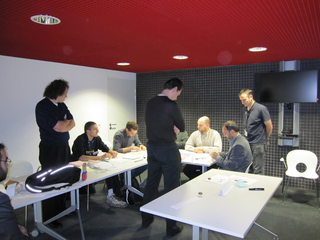 What Went Well What Went Well
- Both conferences were relatively small (fewer than 100 participants) with three tracks, so that it was possible to meet many of the participants and the audience sizes weren’t too large.
- A mixture of foreign and local presenters. Although, in Lille the presenter from Toulouse was more foreign than the one from Belgium 🙂
- Participants to both workshops happily played along and told me they had learned some useful techniques.
- Going to lunch and dinner with local agilistas and hearing about their challenges and successes.
- I’ll be back soon in Besançon.
- I hope I’ll be back soon in Lille, and this time not just as a train stop between London and Brussels.
- Participating in Christophe Thibaut’s well-rehearsed and interactive Haskell kata and going off the cliff with him as we “implemented just one more small feature” because we took too big a step and failed to really let the tests drive the code.
- Participating in Olivier Albiez and André Dhondt’s Pomodoro simulation.
- 15 participants for the Conflict Resolution session.
- 8 participants for the Theory of Constraints session is just enough to run the simulation.
What Went Wrong
- My French could be better. It’s sometimes hard to switch between Dutch, English and French from one day to the next. “Today is Friday, this must be France.” 🙂
- Not being able to talk with all the participants I wanted to talk with.
- Only 8 participants for the Bottleneck session.
- Forgot to bring Belgian Chocolate to Besançon, so got lots of “What Went Wrong” feedback.
- My eyes hurt during the Haskell kata session in Lille, probably because of the lighting in the low-ceilinged meeting room.
Puzzles
- What’s the real state of agility in France? It seems that there’s less uptake than in the “Anglo-Saxon-oriented” countries (UK, the Flemish part of Belgium, Netherlands, Scandinavia, Finland). Why? Is the language a factor?
- Where are the French-speaking Belgian Agilists hiding? I know only three, but there must be more.
Lessons Learnt
Merci aux organisateurs, orateurs et participants. Et, qui sait, à l’année prochaine?
Tried Out
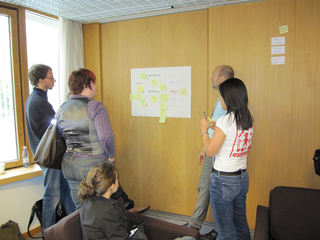 When presenters propose sessions for XP Days Benelux, we always recommend they try out their session, as many times as possible. We should all know the power of iteration and feedback. You need some time to get it right. If you’re slow like me, you might need years to get it right. When presenters propose sessions for XP Days Benelux, we always recommend they try out their session, as many times as possible. We should all know the power of iteration and feedback. You need some time to get it right. If you’re slow like me, you might need years to get it right.
The first tryout of the “Solve Conflicts without Compromise” session was run as a “Birds of a Feather” session several years ago at the SPA conference. The session (and the technique) worked, but only barely. Then, two breakthroughs happened at the same time:
Suddenly, the technique became a lot clearer. Bill Dettmer’s explanation is very clear and practical; the session at Agile 2008 showed that it worked and could be fun.
Solve Conflicts without Compromise
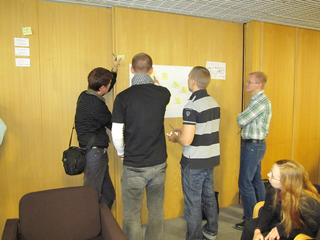 So, after a few more iterations, an updated session was created. It’s now been run twice: So, after a few more iterations, an updated session was created. It’s now been run twice:
- At Agile Tour Besançon, in French. The participants gave a lot of useful feedback at the retrospective.
- At the Scandinavian Agile open space, in English. The pictures show the three groups analysing a conflict for their “customers”. There was no time for a retrospective, because the conference was closing. I hope the three clients will blog or email me about their experience.
The next two runs will be at the Belgium Agile/XP User Group meeting on November 5th 2009 and at the XP Days Benelux conference on November 24th.
So, what are the 7 steps?
- Create a blank Conflict Resolution Diagram (CRD) like in the image below. 5 boxes connected with arrows. Easy.
- Articulate the conflict. State the problem in one of two forms, both impossible choices between conflicting prerequisites:
- One chain of reasoning says “DO THIS”; another chain of reasoning says “DON’T DO THIS”. Now I have to choose: DO THIS OR DON’T DO THIS? I can’t have both.
- I need two things, A and B, but they’re mutually exclusive. Now I have to choose: HAVE A OR HAVE B? I can’t have both.
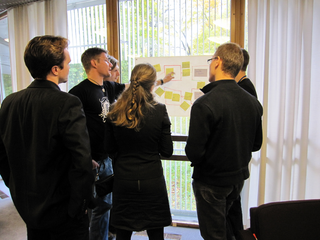 Determine the goal and requirements on each side? Why do we need those two conflicting things? Because of two requirements. Why do we need those two requirements? Because we need them to reach a common goal. Determine the goal and requirements on each side? Why do we need those two conflicting things? Because of two requirements. Why do we need those two requirements? Because we need them to reach a common goal.- Evaluate the reasoning. Throughout the whole exercise we must ensure we maintain clarity: is each step in the reasoning crystal clear and well-understood by everyone? Is the reasoning clear?
- Develop underlying assumptions. If the CRD says “To achieve X we need Y”, ask “Why do we need Y to achieve X?”. All the answers are the underlying assumptions of the reasoning. Use “extreme wording” to make the assumptions stand out and almost beg to be invalidated. For example: “Why do we need to introduce Test Driven Development to achieve better quality?” Because…
- TDD is the only way to improve quality
- TDD is the most fun way to develop software
- TDD catches all errors
- Evaluate the assumptions. Which assumptions are valid? Which assumptions are invalid? Which assumptions could be challenged. If there are no valid assumptions behind a step in the reasoning, the reasoning is invalid. At this point, the whole conflict may have “evaporated”.
- Hard: Create injections. This is the creative bit where we find ideas to invalidate those assumptions that hold us back from creating a win-win situation, one where we achieve our goal in a way that satisfies everyone involved.
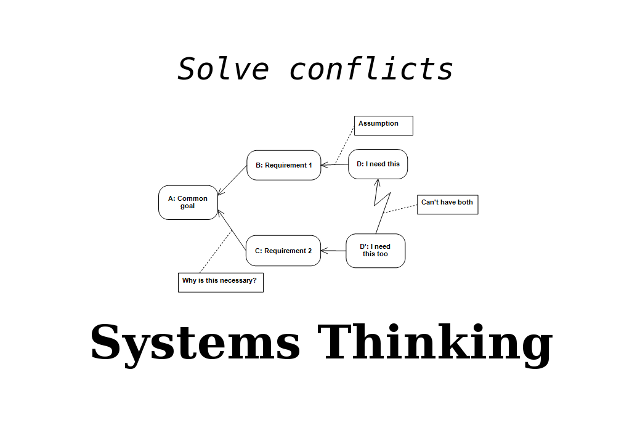 Why is this difficult? Why is this difficult?
When I see the participants in action, there are some difficulties that appear every time:
- It’s hard to maintain the consultant’s stance and only ask questions. That’s why we have strict rules about what the consultants can do: they can only ask a limited set of questions.
- We want to jump to the solution immediately without taking the time to understand the real problem. That’s why the session doesn’t allow talking about solutions, only about problems.
- We censor our assumptions. Instead of brainstorming all our assumptions, we only talk about those that seem reasonable. That’s why there’s a lot of pressure in the session: you have to come up with at least 25 assumptions in 5 minutes. That’s just not possible if you think about the assumptions.
- The most interesting assumptions are those that we no longer think about, the things that are “common sense”. That’s why we have people external to the problem questioning the client and why we bring in some “fresh blood” with a fresh perspective halfway through the session.
- It hurts when we really think about a problem. It’s easier to just settle for a compromise. That’s why we can’t accept any solution where one of the involved parties is not completely satisfied with the outcome.
What’s in it for me?
- The CRD provides a structured method to investigate a difficult conflict and channel our creativity.
- You don’t have to settle for compromise and mediocrity. You can get what you really need.
- It’s a lot easier to bring about changes if everyone affected benefits. As Machiavelli noted: “You will only get lukewarm support from those who will benefit from the change and strong resistance from those who stand to lose”. What if there were no losers?
- Your projects can deliver more business value per cost if you can find the breakthrough ideas that make those painful tradeoffs (or more correctly: horse trading) between stakeholder goals unnecessary?
- You can get more sales if your competitors offer “EITHER/OR” solutions and you can offer “AND” solutions. But first the customer has to regain hope that a solution is possible. Going through a CRD exercise with a customer and offering to invalidate all the assumptions that cause their conflict is an offer they can’t refuse.
 What do I need? What do I need?
- A bit of time. Most participants got several ideas to resolve their conflict within the 90 minutes of the session.
- Some simple materials: pen, paper and plenty of Post-Its
- The willingness to think hard
- The openness to share all assumptions
- The courage to challenge every assumption, even those that are “holy” or common sense. Especially those.
It’s simple, but not easy. The question is: do you want an easy life or a meaningful life? That’s the choice you have to make.
Oh! “Easy OR meaningful”? That sounds like a conflict! Why can’t I have both?
How would you evaporate this conflict?
I present the “Resolve Conflicts without compromise” with Jef Cumps at the XP Days Benelux conference on November 24th.
Bring a conflict to the session and come out of the session with several ideas to turn this conflict into a win-win situation. If you don’t have any conflicts, you can learn how to help others solve their conflicts as a Systems Thinking consultant.
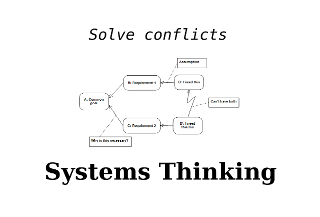
I present the Bottleneck Game at Agile Tour Lille on October 30th 2009.
Come and play to discover the Theory of Constraints and the “Five Focusing Steps” to really improve processes. Experience how and why Agile, Lean and Real Options work.
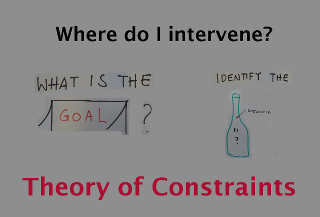

My second visit to Helsinki. Last year’s Scandinavian Agile was great. This year’s was even better.
What Went Well
- Presenting the Toyota Way with Portia. I presented this session for the first time at XP Days Paris 2006. Since then, it has been changed and refined each time it’s run. Most importantly, it includes the stories and experiences we accumulated by applying these techniques over the past years.
- Meeting the other participants over coffee, lunch and dinner and at the pub.
- Running a “Conflict Resolution Diagram” systems thinking session with some 15 participants. More about the technique later.
- Helping Artem Marchenko to run the Business Value Game. It’s always interesting to see how other presenters run the game and “steal” their good ideas.
- The location: beautiful and cold autumn Helsinki. The conference center was ideal for the first day: two large presentation rooms and three smaller workshop rooms, connected by a large open space with coffee and cakes.
- Getting tips for more books from Tom Poppendieck after the Toyota Way session.
- Visiting the Reaktor offices, getting a tour (including the “Russian” room) and discussing sauna’s, Steve Jobs’ management style and the difference between being able to do business analysis and teaching others to do it.
- Discussing Business Value modelling at the Open Space.
- The open space session announcements became more and more original and fun as each presenter tried to top the presenter before them.
- The conference went smoothly and everything was well-organised. Great job, conference organisers!
What Went Wrong
- I didn’t know the contents of the sessions. The schedule overview only contains session titles, with no way to click through to a detailed session description. There were no “session adverts” at the start of the conference, where session presenters could tell me why I should go to their session.
- The morning program was too cramped: what looked like two back-to-back 60 mins sessions were actually two 50 mins session with a 10 minute break. I prefer longer breaks. For example: at XP Days Benelux we have 30 minute breaks between sessions.
- Overrunning the timeslot for the Toyota Way session. We stayed in the timebox during rehearsals, so we need to ensure that we can do it live too.
- The Open Space didn’t make very good use of the room space: the working groups were too close to each other, so that it was difficult to understand each other with all the noise around us. All working groups stayed in their appointed place, while there was plenty of good space going unused in the middle of the room. That just shows how little we question arbitrary constraints.
- To avoid the noise and overcrowding problem, we ran the Conflict Resolution Diagram session downstairs in the coffee room. Unfortunately, we weren’t the only ones, so the session was still too noisy and cramped.
- A participant told me he walked out of the Toyota Way presentation shortly after the beginning because it looked “too basic”.
Puzzles
- Why the need to make “controversial” statements and speeches? It seems to me that the Agile community prefers infighting over advancing the state of the art and delivering value. That is, while there is value in the items on the right, we value the item on the left more. Sectarianism (“Scrum vs Kanban”, “Agile vs Lean”) does not help me do my job.
- Why no Post-Its at the Open Space? How can you expect me to work without Post-Its? 🙂
- Why are so many sessions only about theory, even the one that told us to distrust presenters who present only theory without any concrete examples? Where did you do this? Who were the people who applied this? What were their results?
- What does a maniac with a power drill pointed at me have to do with involving people in Kanban? Karl, your Kanban presentation scared me 😉
 Lessons Learned Lessons Learned
- If you want to run an effective open space, you need the right kind of space. Ideally, separate spaces or rooms that are sufficiently private to allow for discussion and work AND sufficiently public so that it’s easy to go from one space to the other.
- The Conflict Resolution Diagram technique is very simple. It’s also incredibly difficult because you have to question openly, approach a problem with an open mind, take the time to understand the real problem before prescribing a solution and be willing to surface and question all your assumptions. But the reward is huge: you’re able to transform “either this OR that”, “this VERSUS that” and “this OVER that” statements into “this AND that” statements. We can have our cake AND eat it too, if we choose to live a meaningful life and learn to apply some systems thinking.
- The Toyota Way presentation can become better and can be delivered better. See for yourself at XP Days Benelux 2009.
|
|
 What Went Well
What Went Well








